PAINTING
显示 46-60 个结果(共 60 个结果)
显示 46-60 个结果(共 60 个结果)
-
-
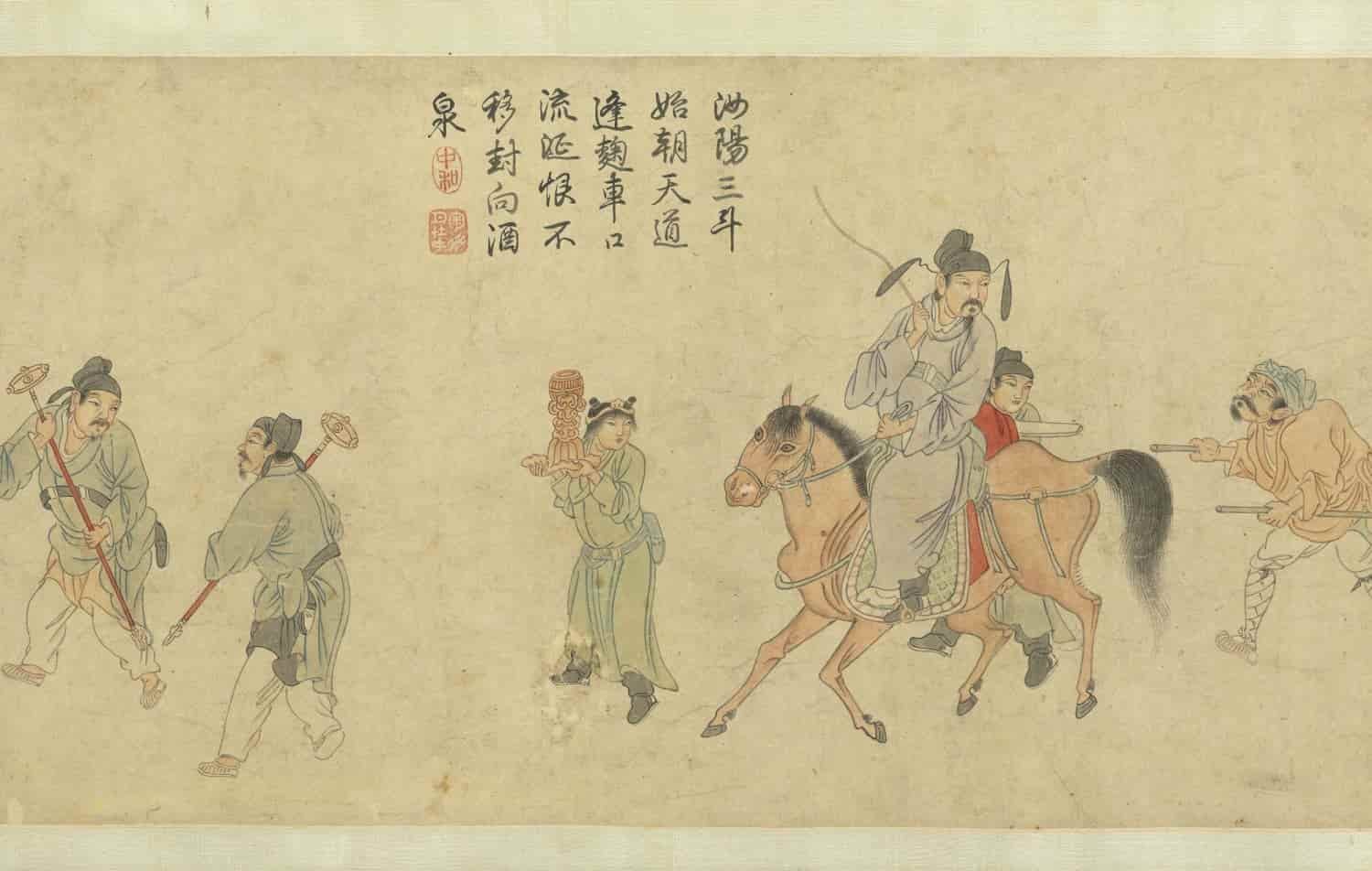
-
促销 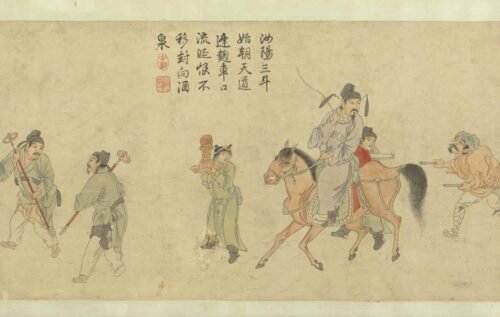
Tang Dynasty Eight Immortals cultural legacy(Scroll)饮中八仙图卷
$3.00原价为:$3.00。$1.50当前价格为:$1.50。 促销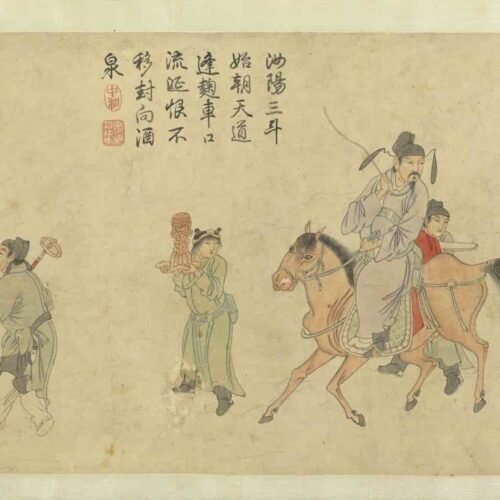
- PAINTING
Tang Dynasty Eight Immortals cultural legacy(Scroll)饮中八仙图卷
(0)$3.00原价为:$3.00。$1.50当前价格为:$1.50。加入购物车Eight Immortals of Wine Scroll” (Yin Zhong Ba Xian Tu Juan)
This Yuan Dynasty handscroll (26.7 x 447.3 cm), attributed to Ren Renfa (1254–1327) but possibly reimagined in the Ming era, captures eight Tang Dynasty literati immortalized in Du Fu’s Ode to the Eight Immortals of Wine. Each scene blends poetic whimsy and social critique:- He Zhizhang sways drunkenly on horseback, “as if sailing a boat”;
- Li Jin, a prince, gazes longingly at wine carts;
- Li Shizhi, a deposed chancellor, drowns political woes in lavish feasts;
- Li Bai sprawls in a tavern, defying imperial summons to declare himself “Wine Immortal”;
- Zhang Xu, the “Sage of Cursive Script,” writes wildly bareheaded.
The scroll critiques Tang court politics through satire (e.g., Li Shizhi’s fall) and celebrates Daoist nonconformity, epitomized by Li Bai’s rebellious spirit. Housed in Taipei’s National Palace Museum, it bears seals of Emperor Qianlong and collector Xiang Yuanbian, embodying the Tang literati’s pursuit of freedom through wine as both muse and metaphor
The products you downloaded are electronic files (JPG or PDF)
-
-
-
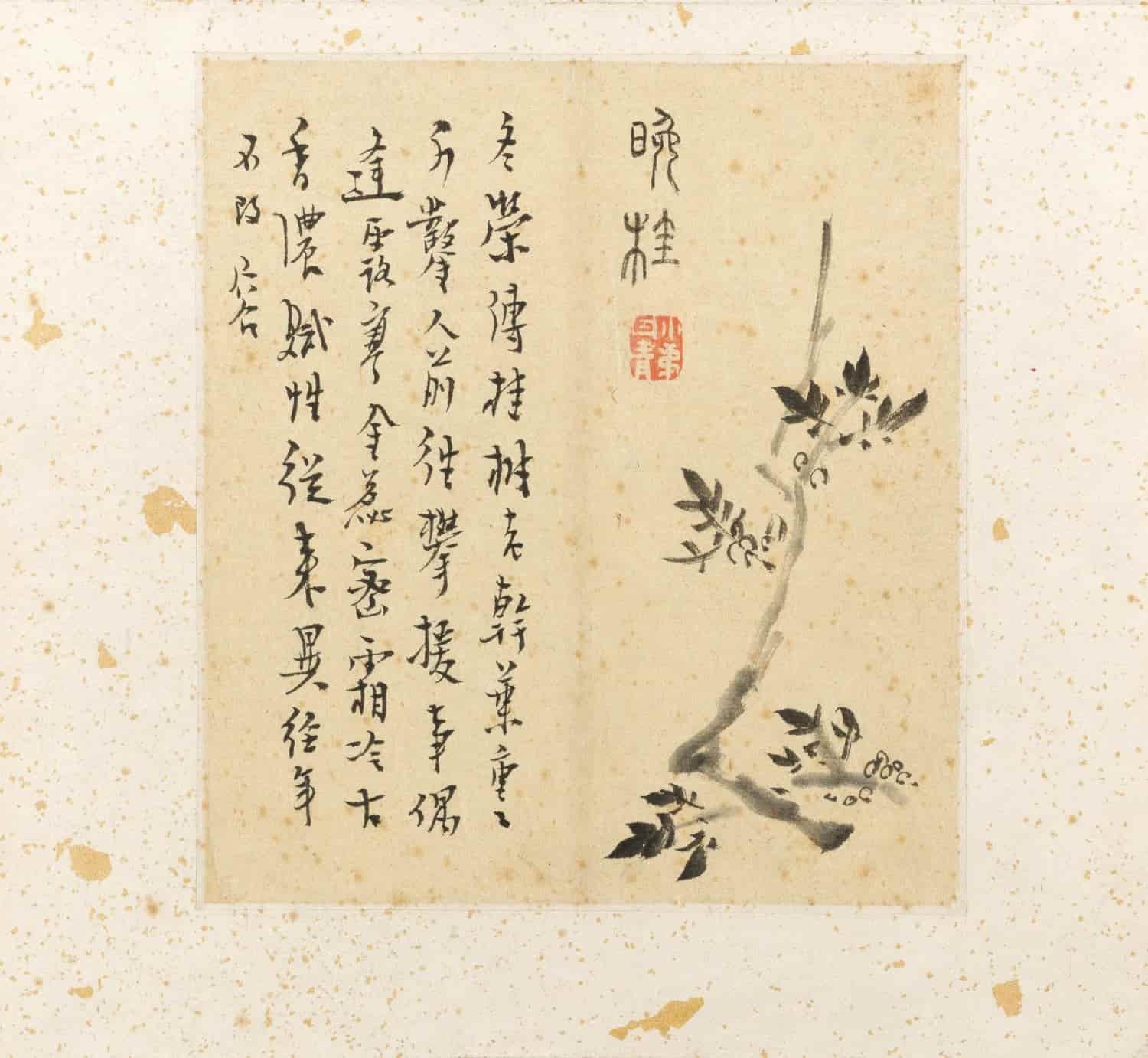
-
促销 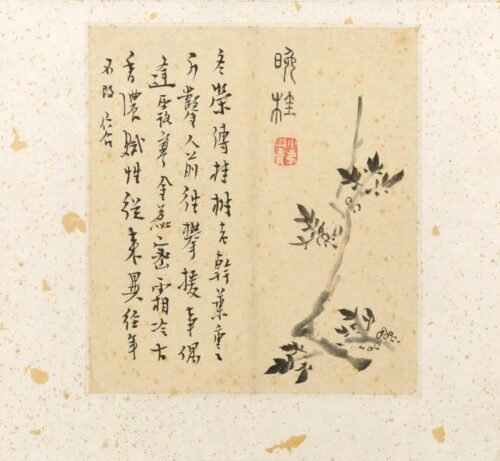
Ten Odes to Solitude An Illustrated Album of the Cold Window(Scroll)寒窗十咏图册
$3.00原价为:$3.00。$1.50当前价格为:$1.50。 促销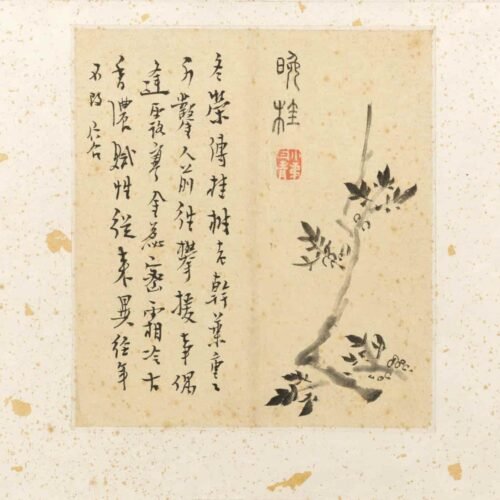
- PAINTING
Ten Odes to Solitude An Illustrated Album of the Cold Window(Scroll)寒窗十咏图册
(0)$3.00原价为:$3.00。$1.50当前价格为:$1.50。加入购物车Ten Odes to Solitude: An Illustrated Album of the Cold Window” (Hanchuang Shi Yong Tuce)
This 10-panel ink album by Gao Xiang (1688–1753), a key figure of the Eight Eccentrics of Yangzhou, captures the poetic decay of ten plants—Withered Lotus, Sparse Paulownia, Winter Vine, Winter Orchid, Aging Willow, Decaying Banana, Late Osmanthus, Fading Chrysanthemum, Ancient Cedar, and Early Plum—through minimalist gongbi brushwork (工笔) and introspective poetry. Measuring 13.6×12.2 cm per panel, the work merges text and image: poems in fragmented xingshu (行书) calligraphy echo the “broken branch” aesthetic of the paintings, while seal-script titles mimic weathered stone inscriptions, foreshadowing Qing-era Stele School calligraphy.Symbolizing resilience in decay, the plants critique Qing opulence and reflect Gao’s reclusive life as a scholar-artist who rejected court patronage. His Zen-inspired focus on impermanence parallels European Vanitas motifs but emphasizes renewal over mortality. Now at Hong Kong’s Art Museum of CUHK, the album bridges Ming loyalist minimalism and avant-garde abstraction, prefiguring 20th-century artistic movements. Gao’s legacy—rooted in poverty, left-handed mastery after paralysis, and defiance of artistic orthodoxy—cements his status as a Qing literati iconThe products you downloaded are electronic files (JPG or PDF)
-
-
-

-
促销 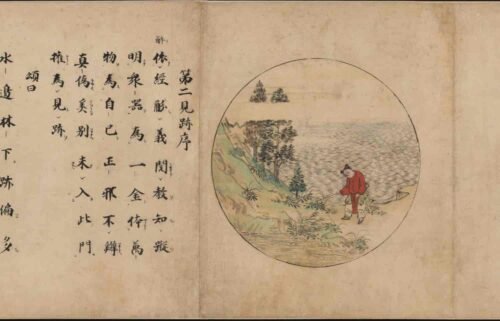
Ten Ox-Herding Pictures with Verses(Scroll)十牛图颂卷
$3.00原价为:$3.00。$1.50当前价格为:$1.50。 促销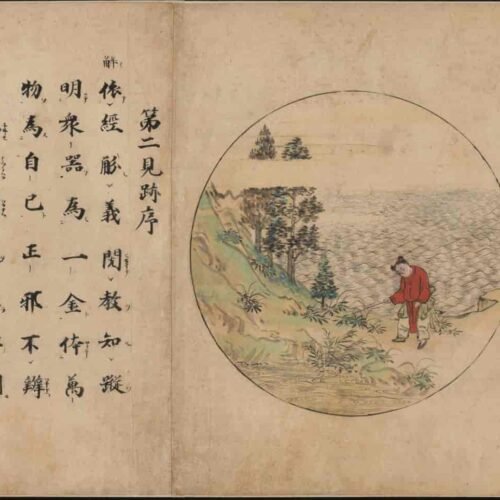
- PAINTING
Ten Ox-Herding Pictures with Verses(Scroll)十牛图颂卷
(0)$3.00原价为:$3.00。$1.50当前价格为:$1.50。加入购物车Ten Oxherding Pictures and Verses” by Chan Master Kuò’ān of Liangshan (《住鼎州梁山廓庵和尚十牛图颂并序》)
This Southern Song Dynasty (12th century) Zen masterpiece by Chan Master Kuò’ān uses ten allegorical stages of taming an ox to map the path to enlightenment, symbolizing the mind’s journey from chaos to clarity. Each stage combines a painting, prose commentary (xu), and verse (song), progressing from Searching for the Ox (delusion) to Entering the Marketplace with Helping Hands (compassionate awakening). The ox represents the untamed mind, while the herder embodies disciplined practice. A 1278 Japanese copy, housed at the Metropolitan Museum of Art, reflects its spread across East Asia. Blending poetic metaphor and Zen philosophy, Kuò’ān’s work remains a cornerstone of Chan/Zen pedagogy, illustrating the paradox of seeking the “unlost” true nature.The products you downloaded are electronic files (JPG or PDF)
-
-
-
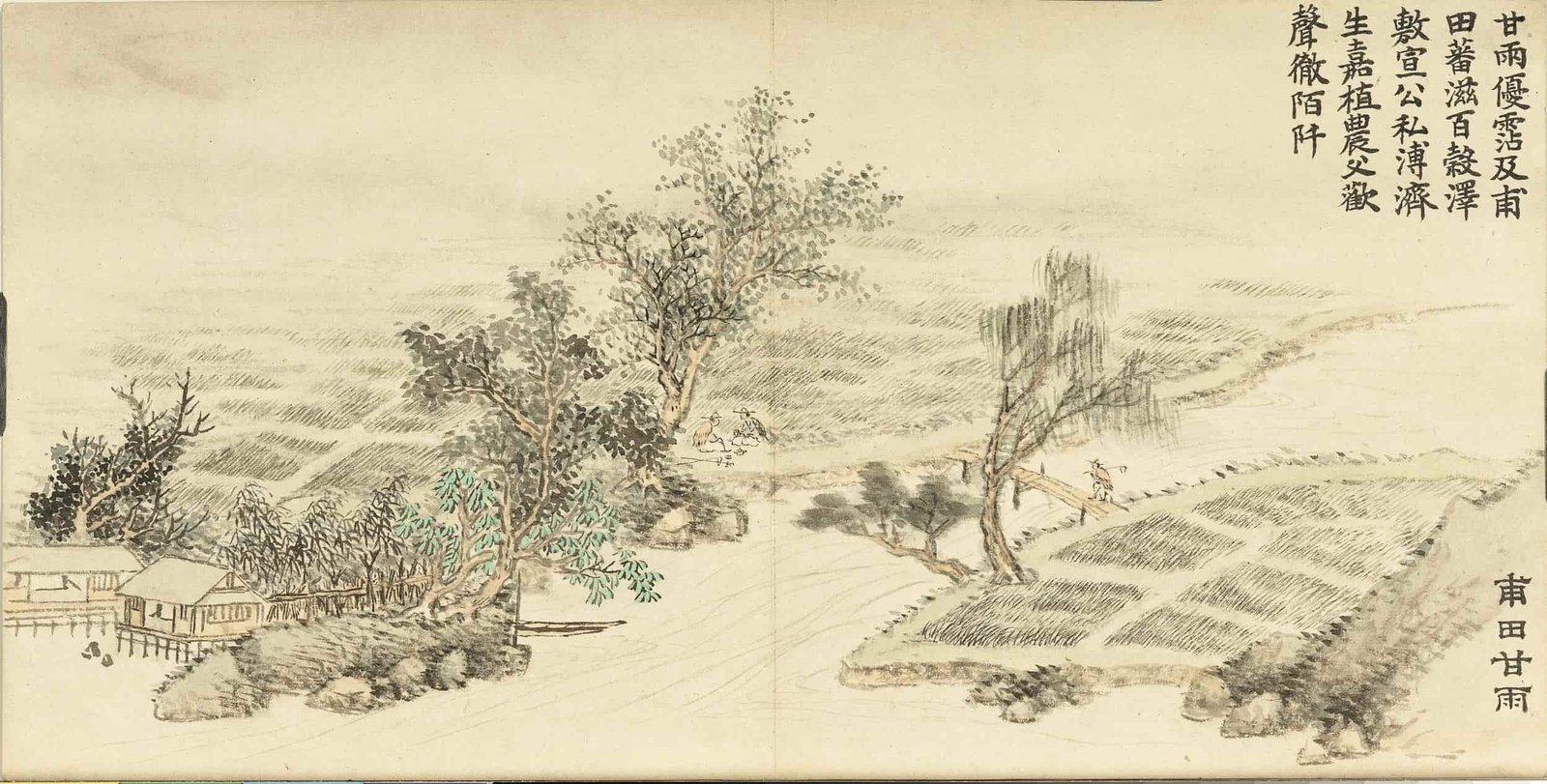
-
促销 
Ten Rains Auspicious Omens Album(Scroll)十雨征祥图册
$3.00原价为:$3.00。$1.50当前价格为:$1.50。 促销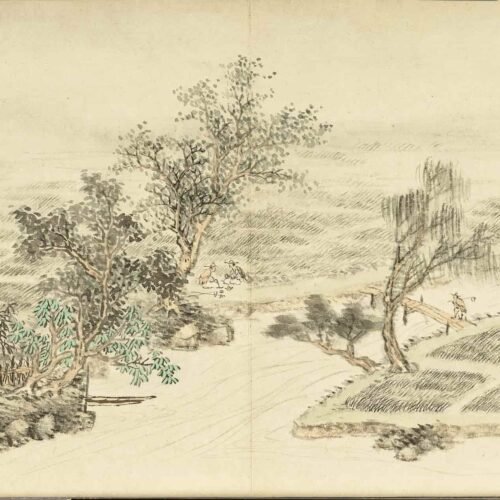
- PAINTING
Ten Rains Auspicious Omens Album(Scroll)十雨征祥图册
(0)$3.00原价为:$3.00。$1.50当前价格为:$1.50。加入购物车Ten Rains: Auspicious Omens Album (十雨征祥图册) is a 10-panel silk-scroll masterpiece by Qing Dynasty artist Dong Gao (1740–1818), housed in Taipei’s National Palace Museum. Depicting rain across seasons—from gentle spring showers to torrential summer storms—each scene pairs meticulous gongbi brushwork with poetic inscriptions by the Jiaqing Emperor, blending art, governance, and Daoist cosmology.
Key panels like Rain Appreciation at the Thatched Studio (symbolizing scholarly humility) and Night Rain in the Xiao-Xiang Region (evoking mythical melancholy) use rain as a metaphor for renewal and cosmic balance. Dong’s mineral pigments capture textures like rain-drenched bamboo and lotus leaves, while imperial poems reflect Confucian ideals of agrarian prosperity[^previous].
The album aligns with the 24 Solar Terms, linking seasonal rains to agricultural cycles, and draws parallels to Su Shi’s Rain Pavilion Record, celebrating rain’s life-giving power. Digitized for global access, it was exhibited in 2024’s Rhythm of the Cosmos (Shanghai), bridging Qing aesthetics with ecological philosophy.
The products you downloaded are electronic files (JPG or PDF)
-
-
-

-
促销 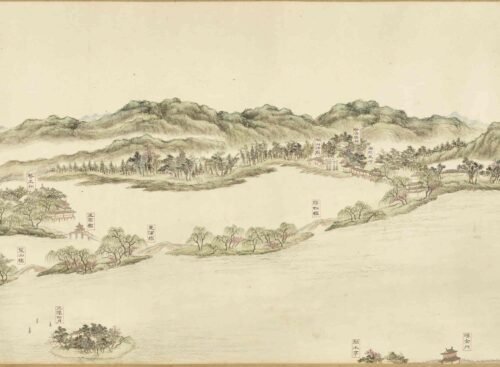
Ten Scenes of West Lake Scroll西湖十景图卷
$3.00原价为:$3.00。$1.50当前价格为:$1.50。 促销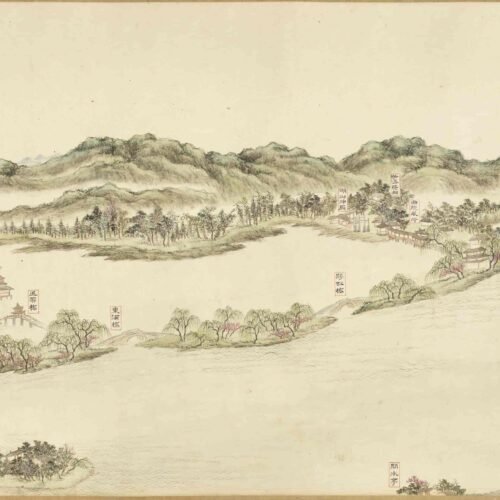
- PAINTING
Ten Scenes of West Lake Scroll西湖十景图卷
(0)$3.00原价为:$3.00。$1.50当前价格为:$1.50。加入购物车Ten Scenes of West Lake Scroll” (《西湖十景图卷》)
Painted in 1750 by Dong Bangda (董邦达, 1696–1769), a Qing Dynasty scholar-official and court artist, this silk handscroll blends cartographic precision with poetic lyricism to depict Hangzhou’s iconic West Lake. Commissioned as a visual guide for Emperor Qianlong’s first southern tour, it expands the traditional “Ten Scenes” to 54 annotated landmarks, including Su Causeway’s spring willows, Leifeng Pagoda’s sunset glow, and the moonlit Three Pools. The work, now housed in the National Palace Museum, Taipei, reflects Qing imperial efforts to revive Southern Song aesthetics while showcasing Dong’s mastery of dry ink techniques and literati spontaneity. Qianlong’s inscribed colophon reveals his anticipation to “verify painted mists against real waters,” cementing the scroll’s role as both artistic marvel and political propagandaThe products you downloaded are electronic files (JPG or PDF)
-
-
-
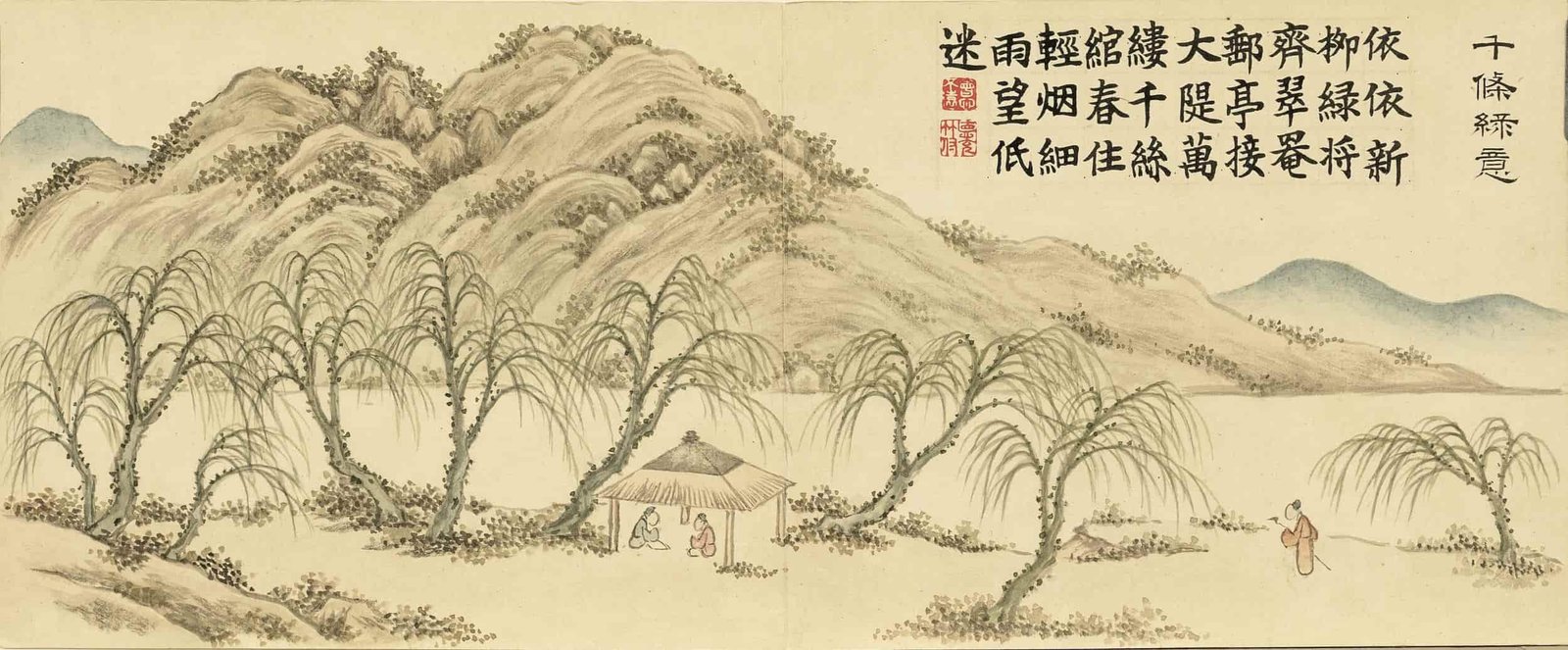
-
促销 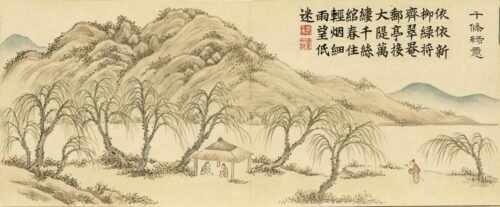
Ten Thousand Auspicious Omens for the New Year Album(Scroll)岁朝衍万图册
$3.00原价为:$3.00。$1.50当前价格为:$1.50。 促销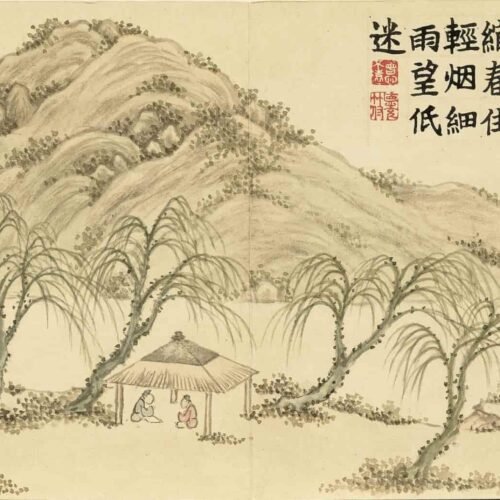
- PAINTING
Ten Thousand Auspicious Omens for the New Year Album(Scroll)岁朝衍万图册
(0)$3.00原价为:$3.00。$1.50当前价格为:$1.50。加入购物车Ten Thousand Auspicious Omens for the New Year Album(歲朝衍萬圖冊) is a 14-panel silk-scroll masterpiece by Qing Dynasty scholar-official Dai Quheng (1755–1811), housed in Taipei’s National Palace Museum. Created in 1805 under Emperor Jiaqing’s patronage, it blends meticulous gongbi brushwork with poetic imperial inscriptions to celebrate Lunar New Year themes of renewal, agrarian prosperity, and cosmic harmony.
Each panel’s title follows a numerical sequence (1 to 100 million), symbolizing infinite cyclical renewal. Highlights include First Blossom of Spring (resilient plum blossoms), Three Suns Herald Prosperity (Daoist cosmic balance), and A Billion Lives in Harmony (utopian imperial unity). Dai’s mineral pigments and translucent layering evoke textures like frost-kissed petals and lantern-lit streets, while Jiaqing’s poems intertwine Confucian governance with Daoist yin-yang philosophy.
Dai, a Grand Secretary and imperial examination top scorer (Zhuangyuan), infused the work with scholarly precision and diplomatic symbolism. Digitized for global access and featured in Cosmic Order: Qing Dynasty Court Art (2024), the album contrasts Japanese kachō-ga in its imperial narrative and European still lifes in philosophical depth, embodying Qing intellectual grandeur and ecological aesthetics.
The products you downloaded are electronic files (JPG or PDF)
-
-
-
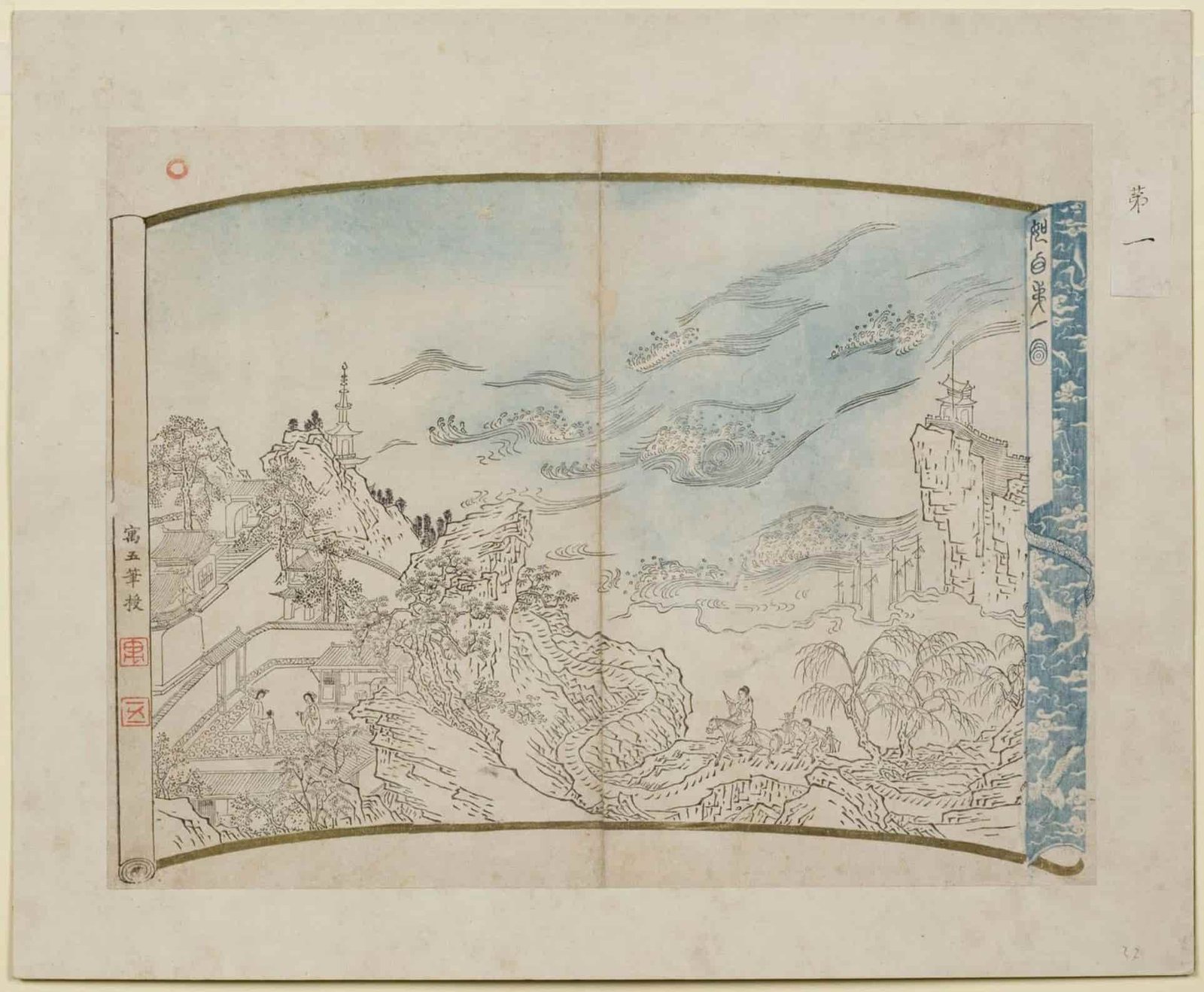
-
促销 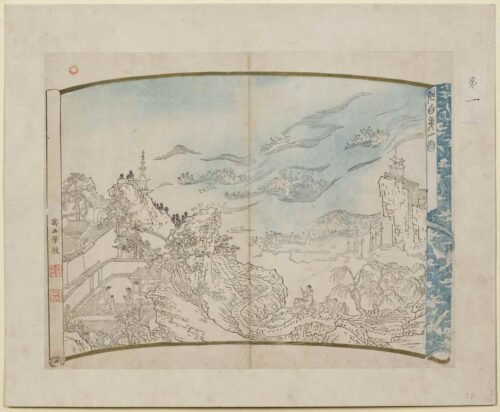
The Romance of the West Chamber Woodblock Prints(Scroll)西厢记版画
$3.00原价为:$3.00。$1.50当前价格为:$1.50。 促销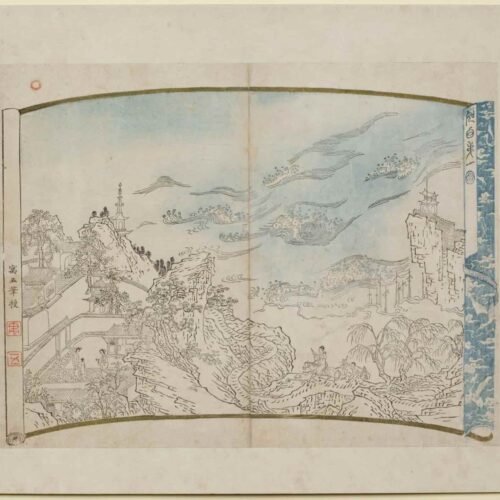
- PAINTING
The Romance of the West Chamber Woodblock Prints(Scroll)西厢记版画
(0)$3.00原价为:$3.00。$1.50当前价格为:$1.50。加入购物车“The Romance of the West Chamber” Woodblock Prints (西厢记版画) are a 21-panel Ming Dynasty masterpiece created by publisher-artist Min Qiji (闵齐伋) in 1640. Housed in Cologne’s Museum of East Asian Art, this series reimagines China’s iconic Yuan Dynasty love story through groundbreaking six-color split-block printing (饾版), blending theatrical drama with Zen philosophy.
Key innovations include:
- Surreal compositions: Scenes unfold on revolving lanterns, bronze vessels, and puppet stages, merging narrative with Daoist cosmology (e.g., astrological compasses mapping romantic destiny).
- Symbolic layering: Mirrored reflections question reality, while empty bridal beds critique earthly desires.
- Technical virtuosity: Up to 54 carved blocks per print achieved Tang mural-inspired gold gradients and Ming porcelain-like malachite greens.
The prints’ global influence spans 17th-century Jesuit-inspired chinoiserie to 2024 Venice Biennale digital revivals. Min’s work transcends illustration, weaving love, illusion, and Ming existentialism into a visual koan.
The products you downloaded are electronic files (JPG or PDF)
-
-
-
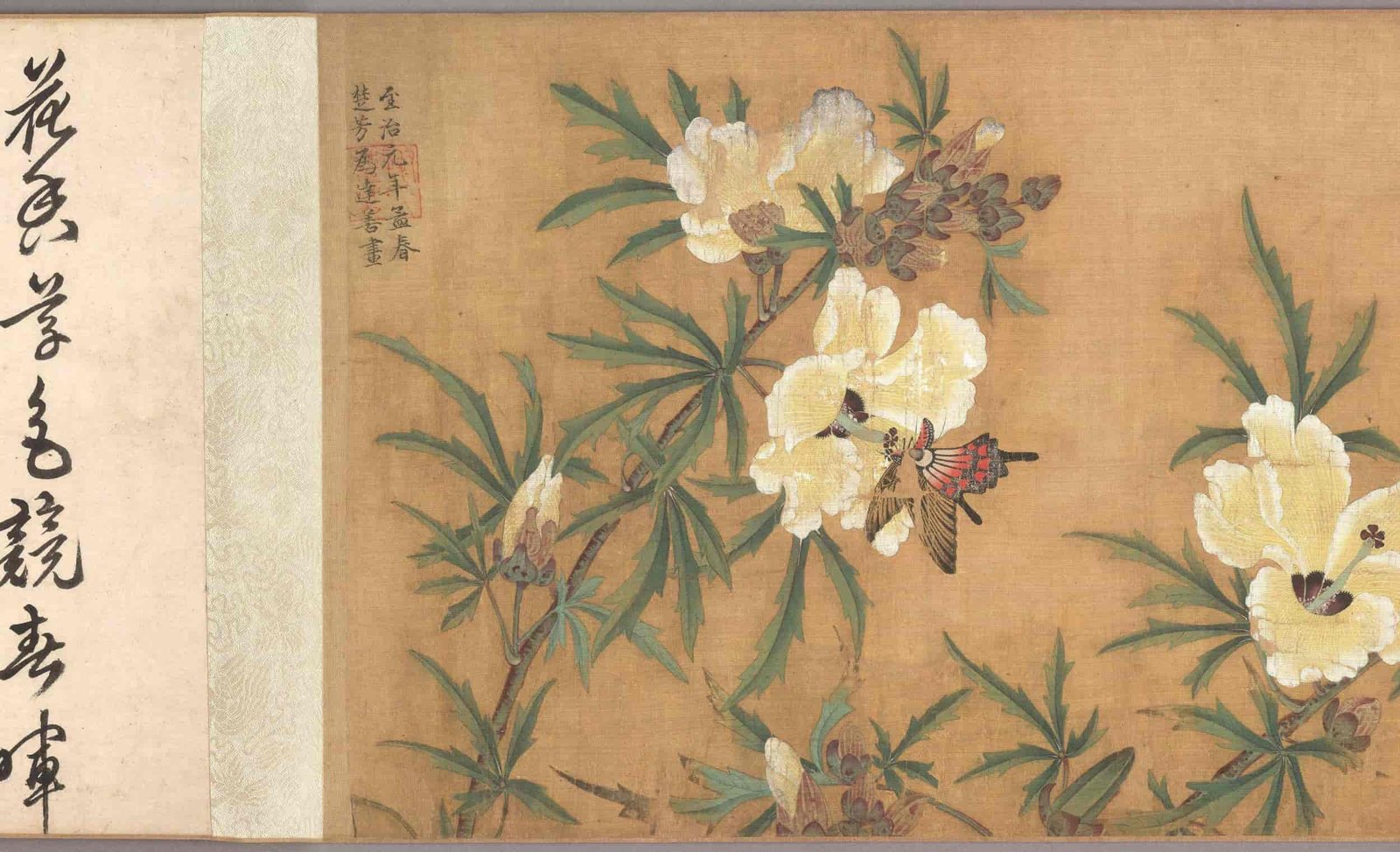
-
促销 
The Vitality of Heaven and Earth (scroll)乾坤生意图卷
$3.00原价为:$3.00。$1.50当前价格为:$1.50。 促销
- PAINTING
The Vitality of Heaven and Earth (scroll)乾坤生意图卷
(0)$3.00原价为:$3.00。$1.50当前价格为:$1.50。加入购物车Xie Chufang’s Qiankun Shengyi Tu (《乾坤生意图》, The Vitality of Nature Scroll)
A masterpiece of Yuan Dynasty (1321 CE) meticulous brushwork by Xie Chufang, this silk handscroll (27.8 cm × 352.9 cm) depicts the brutal yet poetic struggle for survival in the natural world through six scenes of predator-prey interactions. Set against vibrant flora, the scroll reveals hidden dramas: a toad stalking ants dismembering a butterfly, a mantis ambushing a cicada unaware of a lurking tree frog, and wasps attacking a damselfly near a bamboo hive. Though superficially idyllic, these scenes metaphorically critique the political turmoil of Yuan-era China, where Mongol rule and societal corruption forced intellectuals into existential dilemmas—collaborate for survival or resist and perish.Acquired by the British Museum in 1998, it bears the 1797 seal of British collector William Butler, marking it as the earliest known Chinese painting in UK collections. With its blend of scientific precision (detailed insect anatomy) and Daoist symbolism, the scroll is a rare surviving work of Xie Chufang, an obscure artist linked to the Piling School of Jiangsu. Its historical significance lies in both its artistic merit and its role in Sino-British cultural exchange, having likely reached Europe via 18th-century trade or diplomatic channels.
The products you downloaded are electronic files (JPG or PDF)
-
-
-
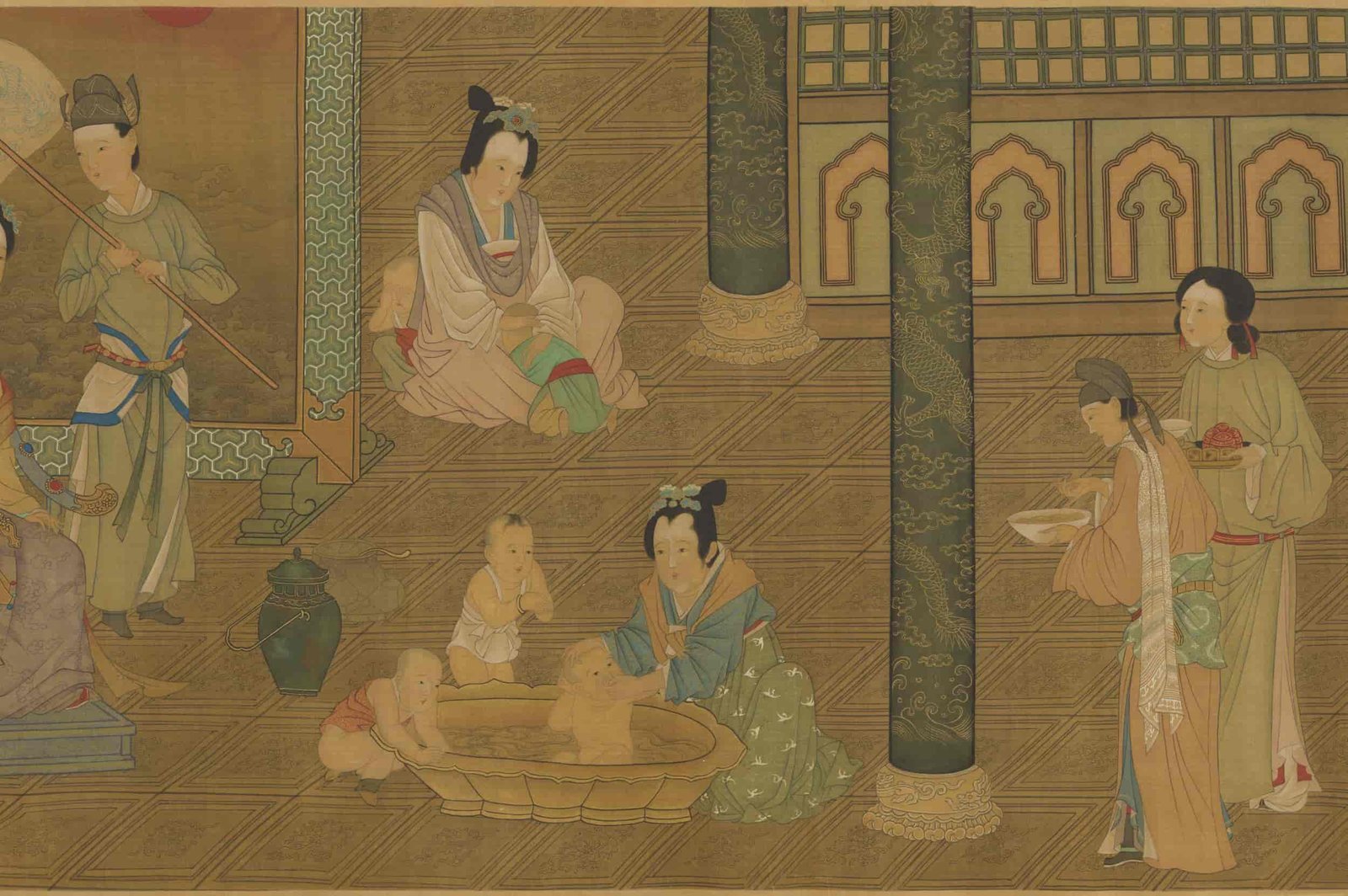
-
促销 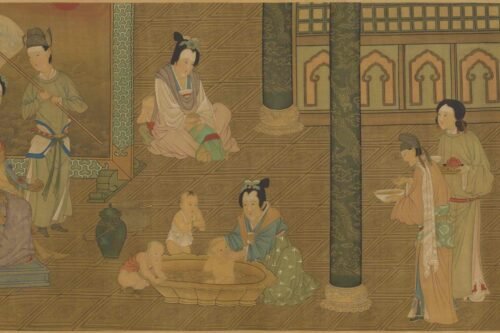
The Vitality of Heaven and Earth (scroll)乾坤生意图卷
$3.00原价为:$3.00。$1.50当前价格为:$1.50。 促销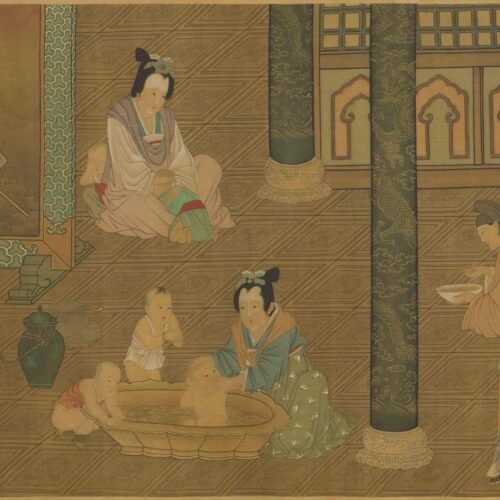
- Chinese Scroll
The Vitality of Heaven and Earth (scroll)乾坤生意图卷
(0)$3.00原价为:$3.00。$1.50当前价格为:$1.50。加入购物车Zhou Fang’s Linzhi Tu (《麟趾图》, Scroll of the Qilin’s Hoof)
Attributed to Tang Dynasty painter Zhou Fang (周昉, c. 730–800 CE), this silk handscroll (39.6 cm × 327.7 cm) depicts idyllic scenes of imperial concubines and children in a Tang palace garden—bathing infants, chasing butterflies, and gathering lotus flowers. Though bearing Zhou Fang’s signature and Yuan-era colophons by scholars Yu Ji and Zhang Yu, scholars classify it as a Ming Dynasty Suzhou workshop imitation (16th century). The scroll blends Tang aesthetics (rounded faces, high-waisted robes) with Ming reinterpretations, such as a seated consort borrowed from Qiu Ying’s Han Palace Spring Morning.The title Linzhi (麟趾, “Qilin’s Hoof”) references The Book of Songs (《诗经》), where the mythical qilin—a benevolent, unicorn-like creature—symbolizes noble virtue. The scenes idealize imperial harmony, masking Ming-era nostalgia for Tang Confucian ideals.
Now housed in the National Palace Museum, Taipei, the scroll exemplifies Suzhou workshop practices: commercial studios mass-produced “antique” works, often forging Tang-Song masters’ signatures to meet Jiangnan elites’ demand for classical art. Despite its inauthenticity, the scroll’s delicate brushwork and layered symbolism (e.g., mother-child motifs) reflect Ming artistry’s fusion of tradition and innovation.
For digitized details, visit the museum’s online collection.
The products you downloaded are electronic files (JPG or PDF)
-
-
-
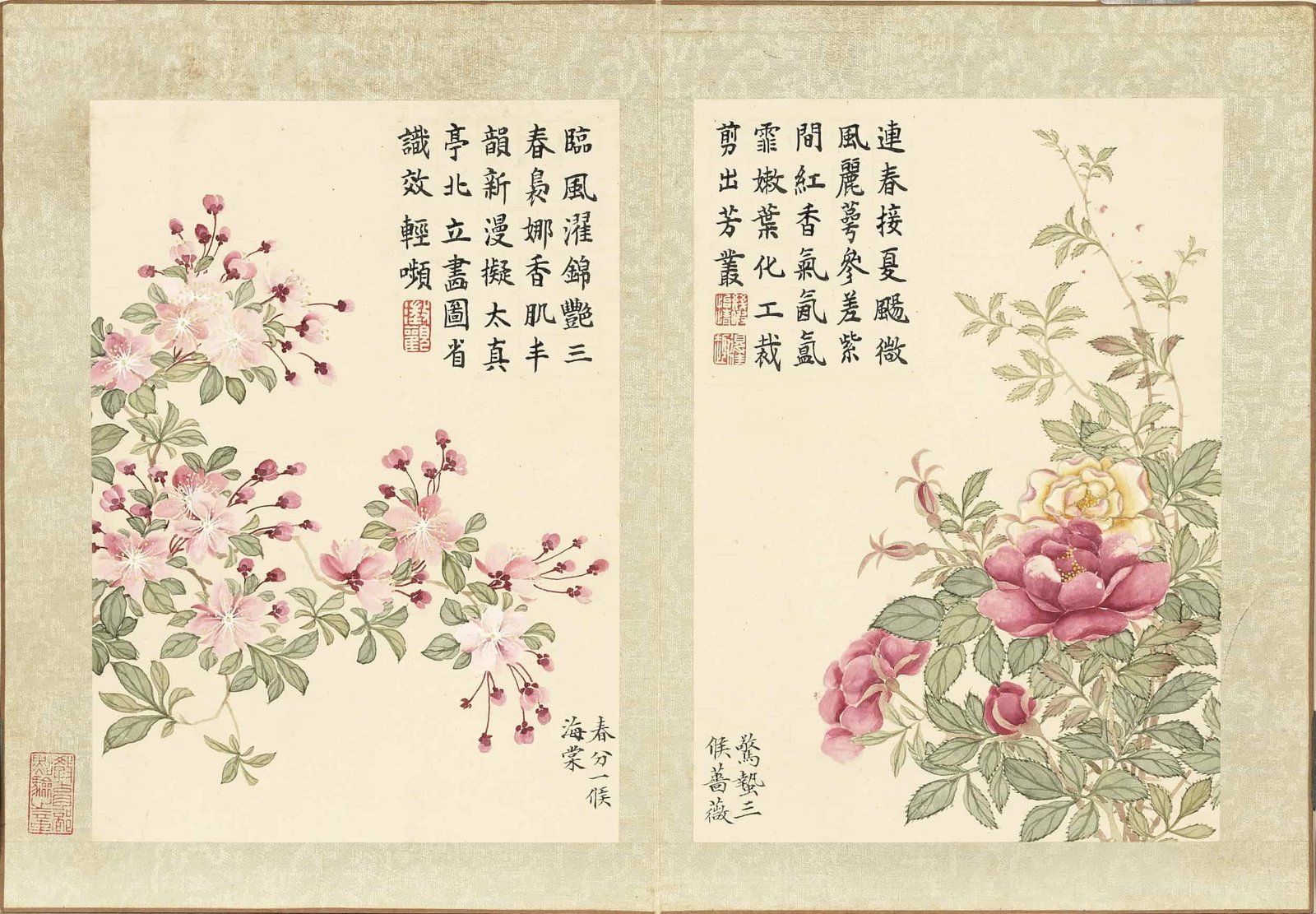
-
促销 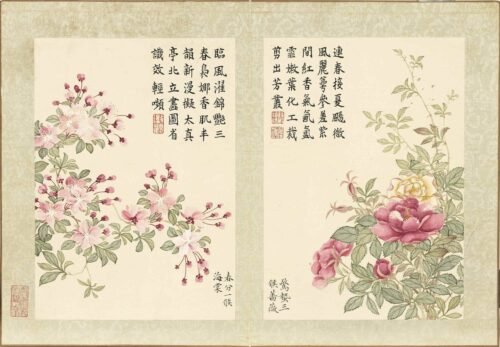
Twenty-Four Floral Messengers An Illustrated Guide to Solar Terms’ Blossoms (Scroll)二十四番花信风图册
$3.00原价为:$3.00。$1.50当前价格为:$1.50。 促销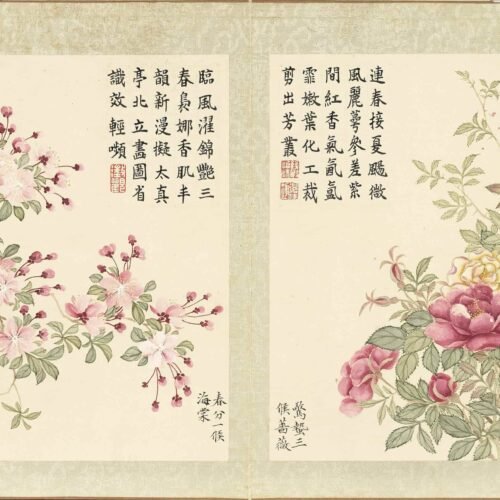
- PAINTING
Twenty-Four Floral Messengers An Illustrated Guide to Solar Terms’ Blossoms (Scroll)二十四番花信风图册
(0)$3.00原价为:$3.00。$1.50当前价格为:$1.50。加入购物车Twenty-Four Floral Messengers: An Illustrated Guide to Solar Terms’ Blossoms (Ershisi Fan Huaxinfeng Tuce)
This 24-panel silk album, created by Qing Dynasty court artist Dong Hao (1740–1818), documents China’s traditional phenological calendar through meticulously painted flowers associated with seasonal winds (huaxinfeng) across eight solar terms, from Minor Cold to Grain Rain. Each panel pairs gongbi-style botanical illustrations (featuring malachite green and gold accents) with Emperor Jiaqing’s seal-script poems, blending scientific precision with lyrical symbolism.Structured around 24 pentads (5-day periods), the work highlights flowers like plum blossoms (resilience in snow) and peonies (imperial grandeur), framing agrarian rhythms through Confucian ideals. Commissioned during political reforms, it subtly critiques Qing bureaucracy by contrasting idealized natural order with contemporary challenges. Now housed in Taipei’s National Palace Museum, the album bridges art and ecology, echoing European medieval herbals while prefiguring modern phenology. Its legacy lies in preserving Ming-Qing environmental wisdom and reinforcing cultural identity through enduring floral symbols
The products you downloaded are electronic files (JPG or PDF)
-
-
-

-
促销 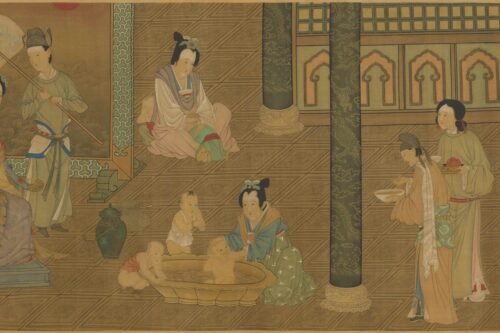
Unicorn’s Hoof (Scroll)麟趾图卷
$3.00原价为:$3.00。$1.50当前价格为:$1.50。 促销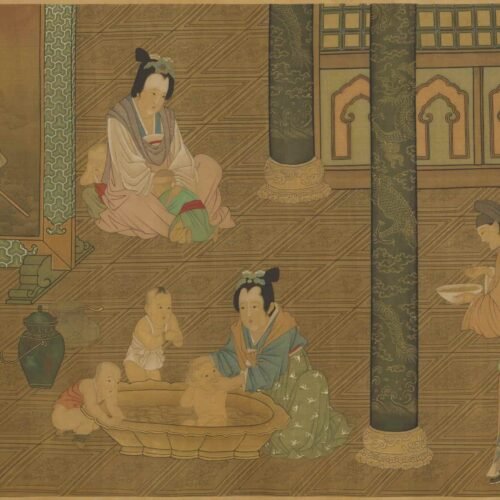
- PAINTING
Unicorn’s Hoof (Scroll)麟趾图卷
(0)$3.00原价为:$3.00。$1.50当前价格为:$1.50。加入购物车The Scroll of the Unicorn’s Hoof (麟趾图卷), attributed to Tang Dynasty master Zhou Fang but actually a Ming-era (16th century) ‘Suzhou fake,’ offers a charming depiction of imperial family life—concubines and princes playing with butterflies and lotus flowers. This handscroll, now in Taipei’s National Palace Museum, blends Zhou Fang’s iconic ‘plump beauty’ style with Ming anachronisms like Qiu Ying-inspired figures, exemplifying how Ming workshops creatively recycled classical motifs for elite collectors. Though bearing forged Tang-era colophons, the work remains culturally significant as both a tribute to Tang aesthetics and a window into Ming artistic commerce.
The products you downloaded are electronic files (JPG or PDF)
-
-
-

-
促销 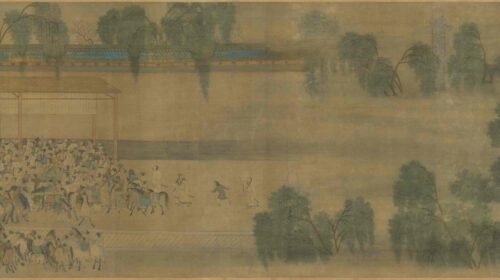
Viewing the Imperial Exam Results Scroll (Attributed to Qiu Ying), Ming Dynasty观榜图卷.
$3.00原价为:$3.00。$1.50当前价格为:$1.50。 促销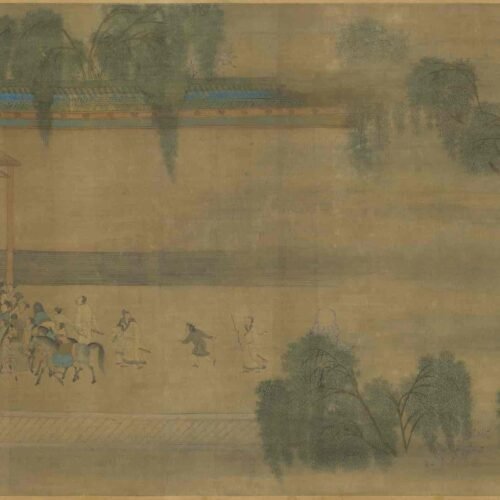
- PAINTING
Viewing the Imperial Exam Results Scroll (Attributed to Qiu Ying), Ming Dynasty观榜图卷.
(0)$3.00原价为:$3.00。$1.50当前价格为:$1.50。加入购物车The Examining the Rankings Scroll (《观榜图卷》) depicts post-exam scenes from China’s Ming-Qing imperial examinations through two versions: a Ming-era scroll (attributed to Qiu Ying) showing crowds celebrating/despairing over results, and a Qing version (by Liang Xian) capturing candidates checking rankings by torchlight at dawn. These works, housed in Taipei’s National Palace Museum, blend artistic detail with historical insight into the three-tier exam system (producing zhuangyuan 状元 top scholars) and its cultural impact.
The products you downloaded are electronic files (JPG and PDF)
-
-
-
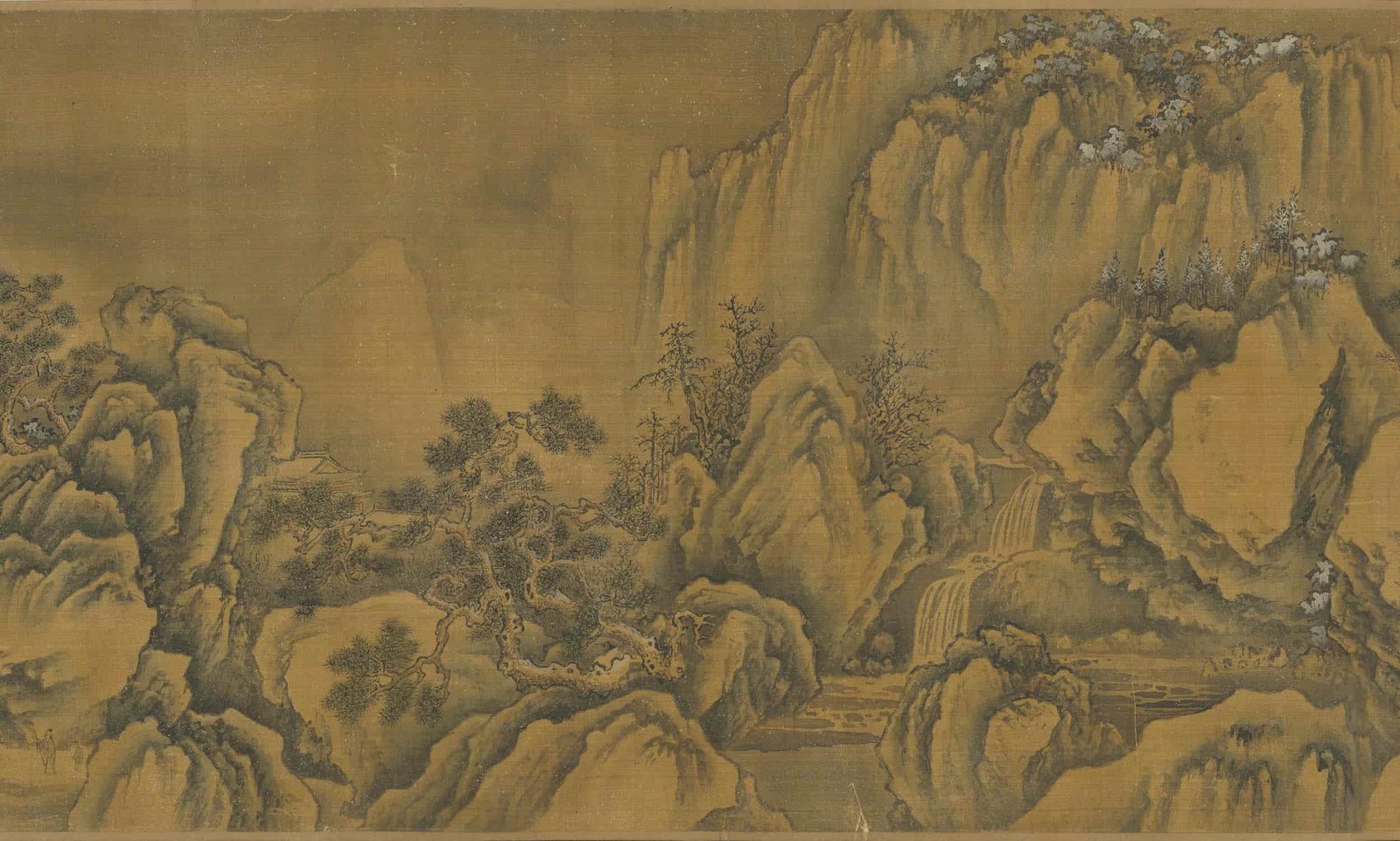
-
促销 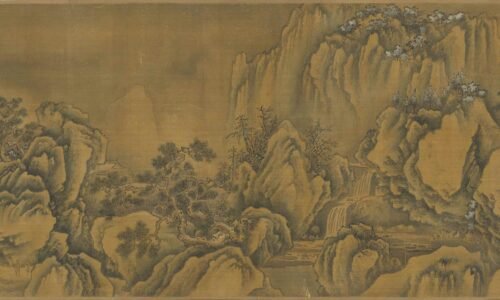
Wang Shen’s snowscape techniques(Scroll)渔村小雪图卷
$3.00原价为:$3.00。$1.50当前价格为:$1.50。 促销
- PAINTING
Wang Shen’s snowscape techniques(Scroll)渔村小雪图卷
(0)$3.00原价为:$3.00。$1.50当前价格为:$1.50。加入购物车Snow in a Fishing Village Scroll” (Yucun Xiaoxue Tu Juan)
This Northern Song masterpiece by Wang Shen (1037–1104), a royal son-in-law exiled after the Wutai Poetry Case, merges poetic solitude and political allegory. Painted on silk (44.4 x 219.7 cm), it juxtaposes a bustling fishing village, a snow-clad central mountain, and a desolate wilderness to symbolize withdrawal from court intrigues. Wang innovatively blended Li Cheng‘s ink austerity and Li Sixun‘s blue-green opulence, using white lead powder for snow and gold outlines to evoke icy sunlight—a fusion of Tang grandeur and Song minimalism. The scroll reflects his dual identity as a disgraced aristocrat and Daoist recluse, critiquing bureaucratic ambition through “fishing” motifs that echo Tang poet Wang Wei’s reclusive ideals. Later inscriptions by Zhao Mengfu and Wen Zhengming hailed its technical precision and philosophical depth. Now in Taipei’s National Palace Museum, it remains a pinnacle of literati painting, bridging Tang decorative brilliance and Song introspection while capturing the tension between imperial duty and spiritual freedomThe products you downloaded are electronic files (JPG or PDF)
-
-
-
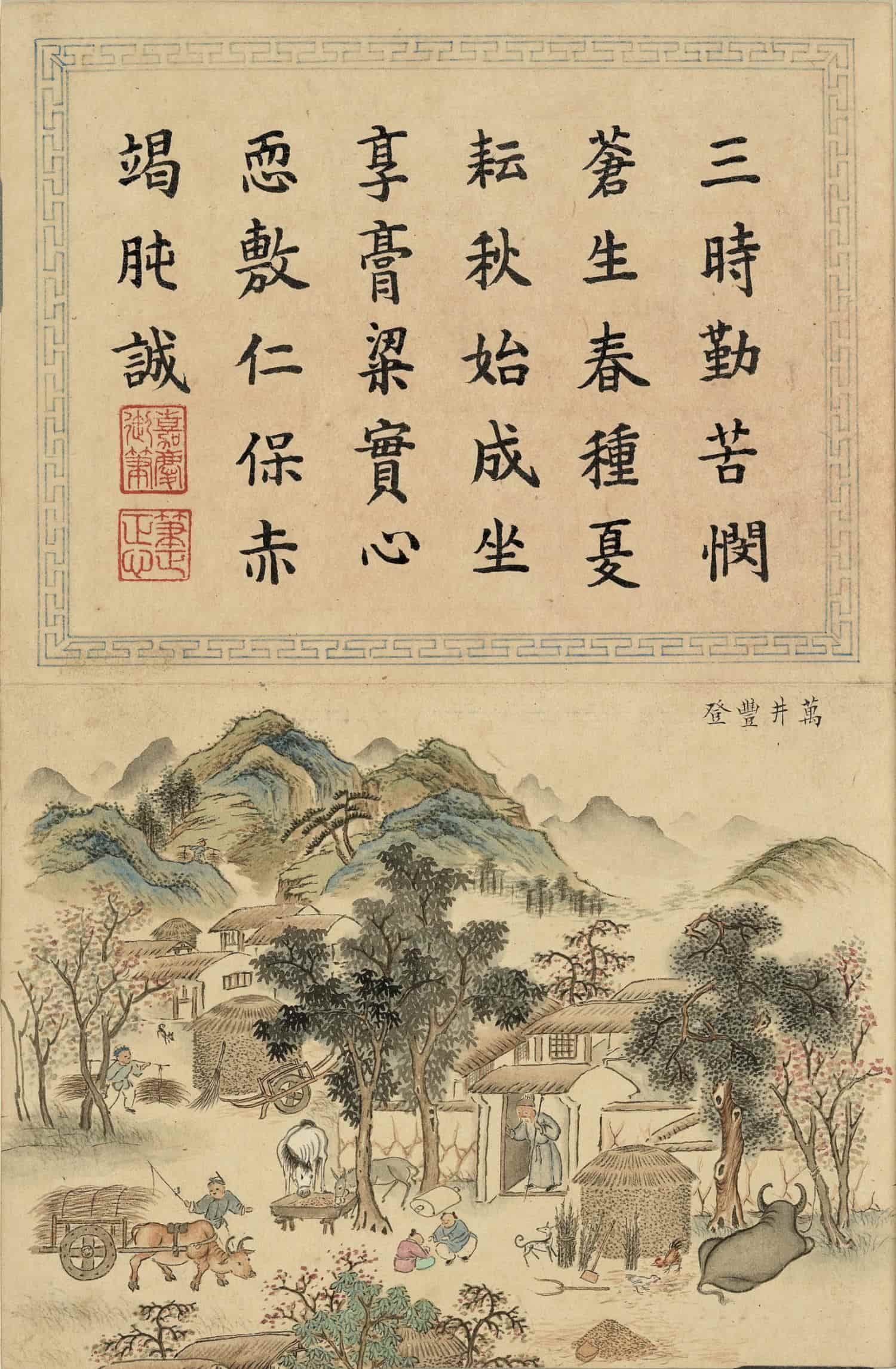
-
促销 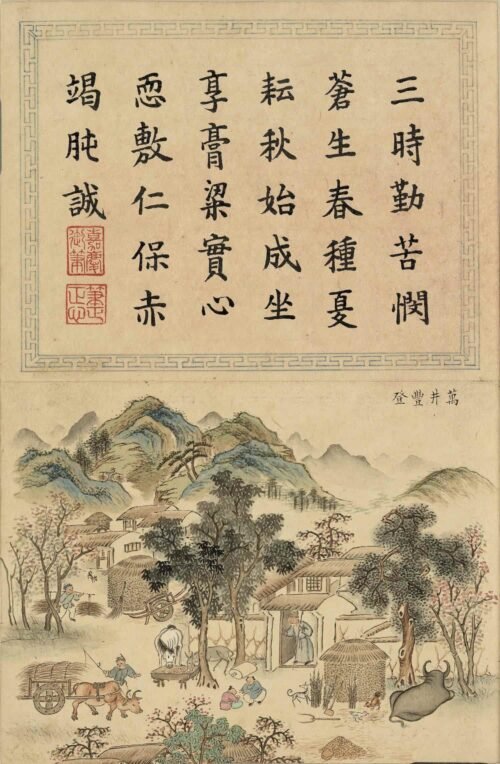
Yichun Shu Rui Tu An Illustrated Album of Auspicious Spring Scene(Scroll)亿春书瑞图册
$3.00原价为:$3.00。$1.50当前价格为:$1.50。 促销
- PAINTING
Yichun Shu Rui Tu An Illustrated Album of Auspicious Spring Scene(Scroll)亿春书瑞图册
(0)$3.00原价为:$3.00。$1.50当前价格为:$1.50。加入购物车Yichun Shu Rui Tu: An Illustrated Album of Auspicious Spring Scenes (亿春书瑞图册)
This 10-panel silk album, created by Liu Quanzhi (1739–1818), a Qing scholar-official and disciple of Ji Xiaolan, blends meticulous gongbi brushwork with Emperor Jiaqing’s poetic inscriptions to celebrate imperial prosperity and agrarian harmony. Each panel centers on a wan (万, “ten thousand”) motif, symbolizing universal abundance under Qing rule—from Ten Thousand Households’ Spring Sounds (萬戶春聲), depicting Lunar New Year festivities, to Tributary States Presenting Treasures (萬邦獻賮), visualizing the empire’s “All Under Heaven” ideology.Rendered in ink and color on silk, the album merges vertical scroll aesthetics with Western-inspired depth, such as receding river perspectives in Calmed Rivers of Ten Thousand Branches (萬派安瀾). Its themes of renewal and governance echo classical texts like the Book of Documents, while its focus on decayed imperial propaganda parallels Kangxi’s Agriculture and Sericulture. Now housed in Taipei’s National Palace Museum, the work exemplifies Qing court art’s fusion of literati ideals and statecraft, cementing Liu’s legacy as a bridge between scholarly allegory and imperial vision.
The products you downloaded are electronic files (JPG or PDF)
-
-
-
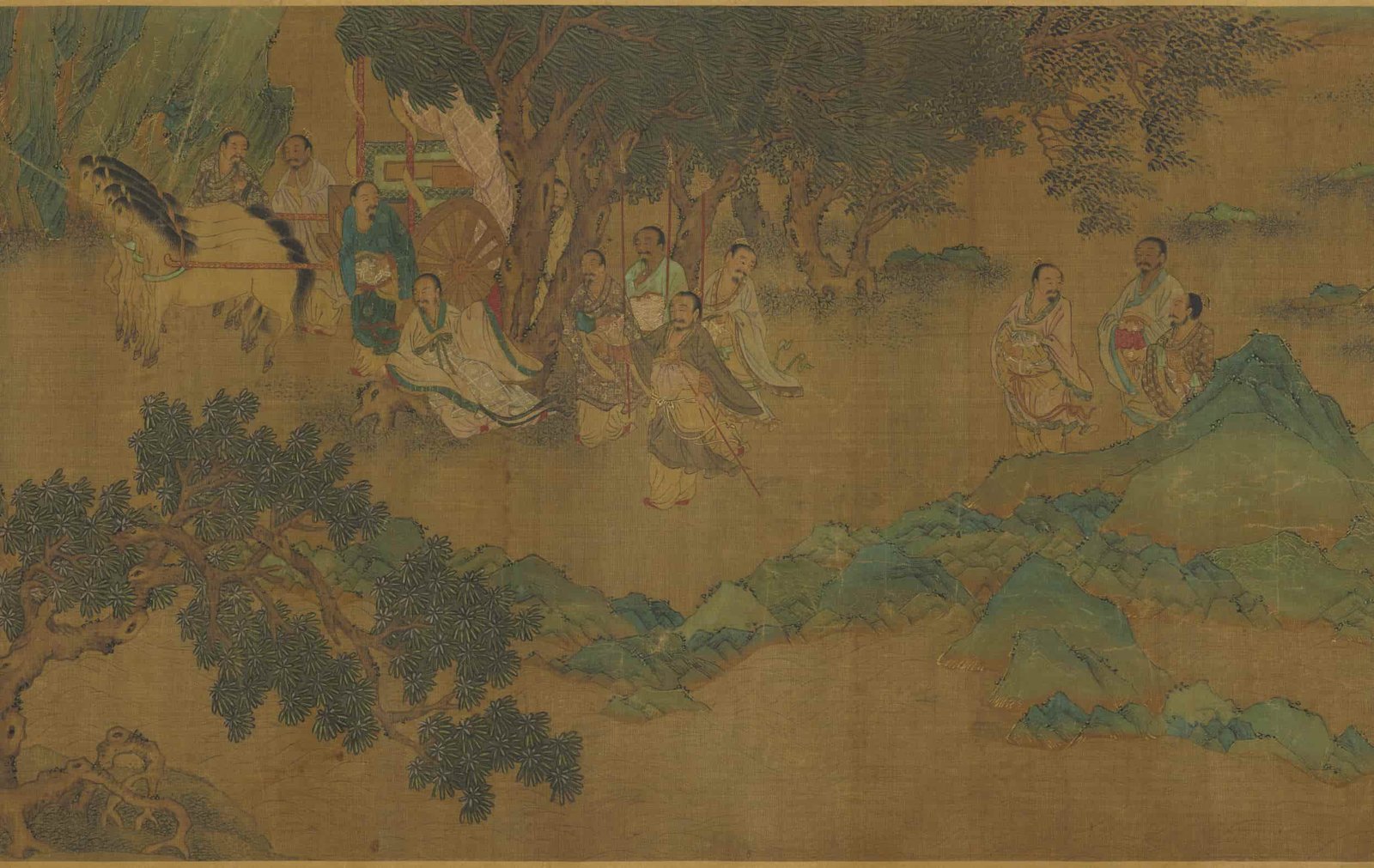
-
促销 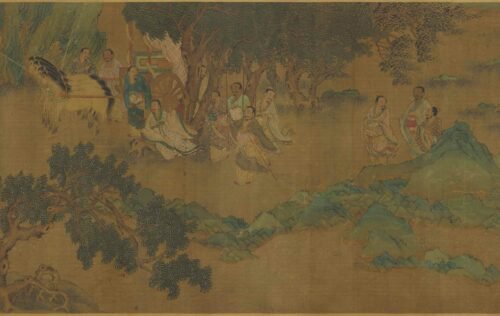
Yu the Great’s mythological and artistic significance(Scroll)禹王治水图卷
$3.00原价为:$3.00。$1.50当前价格为:$1.50。 促销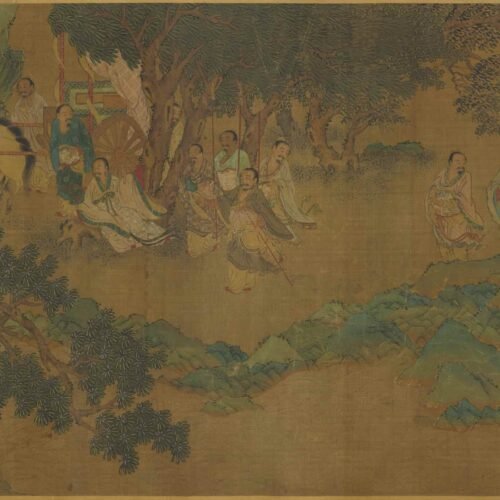
- PAINTING
Yu the Great’s mythological and artistic significance(Scroll)禹王治水图卷
(0)$3.00原价为:$3.00。$1.50当前价格为:$1.50。加入购物车Yu the Great Taming the Floods Scroll” (Yu Wang Zhi Shui Tu Juan)
This Southern Song masterpiece, attributed to imperial clansman Zhao Boju (1120–1182), is a 30.5 x 373 cm silk handscroll blending myth and statecraft. Executed in the blue-green and gold-leaf technique (qinglü miaojin), it vividly portrays Yu the Great’s legendary flood control through three narrative sections: chaotic floods, communal labor, and subdued waters. The scroll contrasts Yu’s innovative channel-digging methods with his father Gun’s failed dams, symbolizing the triumph of collective effort over authoritarian rigidity.Artistic Innovation:
Zhao’s use of malachite greens and azurite blues for swirling rivers, paired with gold accents on cliffs and tools, evokes divine intervention while subtly critiquing Southern Song governance during territorial losses to the Jin dynasty. The composition mirrors Daoist cosmology’s “three phases of cosmic order,” framing Yu’s leadership as both practical and celestial.Symbolism & Legacy:
- Yu the Great: Clad in a black robe (symbolizing water in wuxing theory), he embodies Confucian selflessness, epitomized by his legendary thrice-passing his home without entering.
- Laborers: Their synchronized work with Song-era tools reflects Mencius’ philosophy of communal harmony.
The scroll’s appended Yu Gong text by Yuan scholar Yu Ji reinforces its theme of unity, mapping Yu’s “nine provinces” as a proto-Chinese empire. Later colophons by Yang Weizhen and Wen Zhengming hailed it as a fusion of Tang opulence and Song introspection. Its influence extended to the Qing dynasty, inspiring the Jade Mountain of Yu (1748–1787), a monumental jade carving commissioned by Emperor Qianlong. Now in Taipei’s National Palace Museum, the scroll remains a testament to Yu’s enduring legacy as China’s archetypal engineer-ruler and Zhao Boju’s mastery in bridging myth, art, and political allegory.
The products you downloaded are electronic files (JPG or PDF)
-
